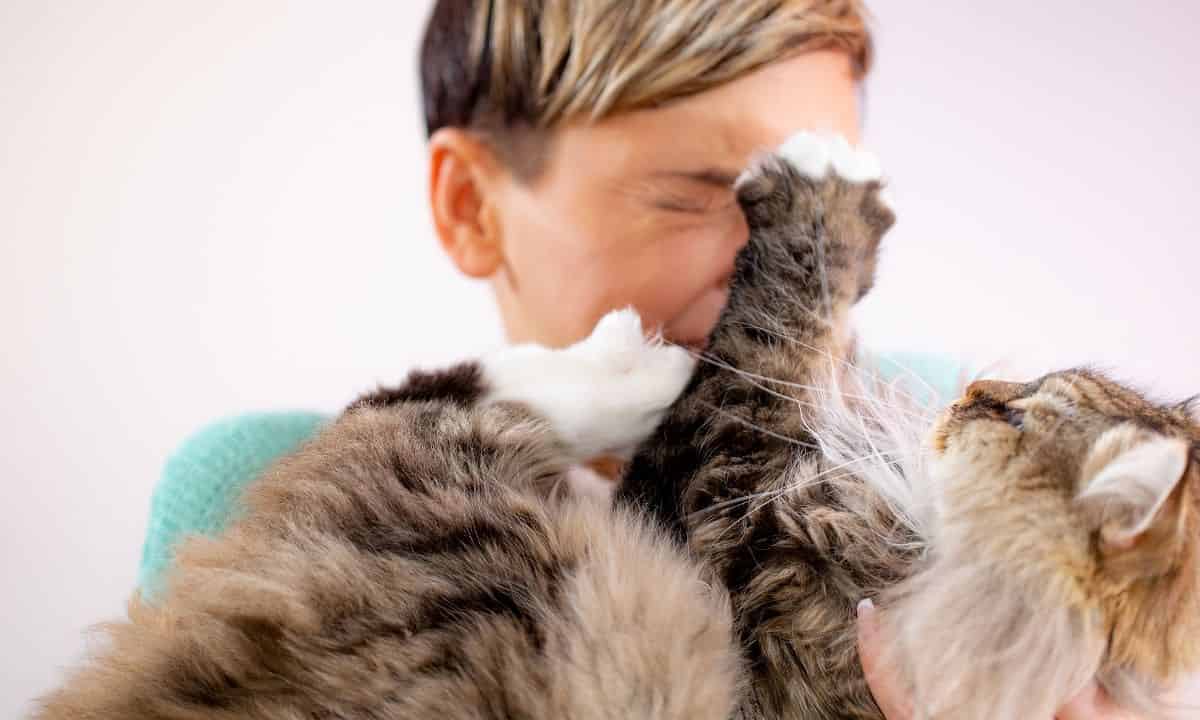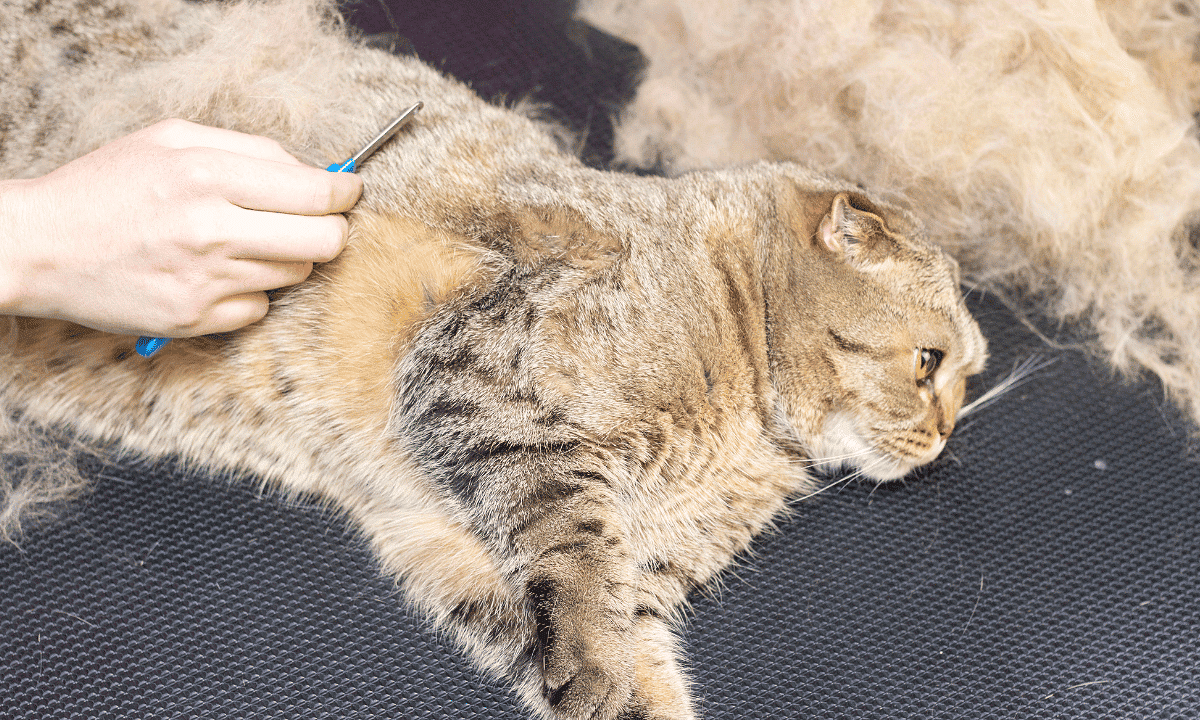Your Cart is Empty
How To Remove Matted Cat Hair
by Dr. Lizzie Youens BSc (Hons) BVSc MRCVS July 04, 2023

Cat hair - it gets everywhere. Little clumps on the carpet or the sofa, handfuls of it when you groom your cat, even tickling your nose when you have a stroke and a cuddle with your pet!
Cat hair is dense and can cause problems if it clumps into thick mats. These can be uncomfortable for cats and indicate an underlying health issue.
When working in a veterinary clinic, it is common to see cats admitted for ‘de-matting,’ to remove these clumps of fur by combing or shaving.
This process can be time-consuming, and occasionally calming or sedative medications must be given to avoid stress or discomfort to the cat.
IN THIS ARTICLE
What Causes Matted Cat Fur

Cats are clean little creatures and spend a lot of time grooming themselves. Their tongues act like small combs, smoothing out the fur and stimulating glands in the skin to produce oils that lubricate the hair. My cats seem to spend much of the day engrossed in preening themselves!
However, mats - tangled and clumped areas of hair - are easily formed, and some circumstances make them more likely to occur.

- Poor grooming
If a cat doesn’t maintain their fur condition, mats can occur when the shedding undercoat gets caught up in the top coat. Cats can stop grooming for a whole variety of issues.
Medical causes, such as illness or pain, can reduce the effectiveness of grooming or restrict your cat’s movement and flexibility so they can’t reach certain areas.
Behavioral problems like stress can also affect a cat’s hygiene routine.
Obesity is a common problem in my patients, and overweight cats often cannot physically groom certain parts of their bodies.
More senior cats may also lose their flexibility and grooming prowess.
2. Long-haired cats
Any cat can become matted, but certain cat breeds are more prone than others due to the sheer volume of hair involved!
Common breeds I have seen in practice needing de-matting often include Persians, Maine Coons, and Ragdolls.
They are all gorgeous, of course, but their dense coats can require a lot of attention!
3. Friction
Mats often occur where there is a lot of movement or contact with surfaces, such as around the armpits, under the armpits, and around the neck.
Exercise and entwining hair can stimulate excess oil production, encouraging the fur to stick together more.
4. Dirty or oily coats
If your cat is adventurous and often returns to the house grubby or sticky, it may be more prone to mats.
Why Is Matted Cat Fur Bad

Matted fur is a problem for cats due to the discomfort caused, as these tight bundles of hair can pull taut, causing irritation and pressure on the skin.
Clumps of fur can prevent air from getting to the skin and encourage dirt, infection, and parasites. The skin under the mats becomes thin and inflamed, predisposing to infection.
The presence of mats is also an indirect concern, as it implies an underlying issue causing a lack of self-hygiene. If I see a cat regularly getting matted fur, I recommend further investigation for an underlying health or behavioral problem.
How To Remove Matted Cat Hair

Mats are unpleasant for your cat and can cause damage to the underlying skin, so it’s essential to remove them.
I inspect my cats’ fur and skin regularly by running my fingers gently over their body to feel for areas of matted hair, but it’s also helpful to check for any skin problems, pain, or wounds. It’s a useful habit for all cat owners to get into!
If your cat appears to be in good health and grooming usually but has the occasional small mat, this can be dealt with at home.
However, if your cat is not grooming well, is unwell, or has multiple and regular areas of matted fur, veterinary advice should be sought. Large mats which are uncomfortable, or are affecting the underlying skin, will also need professional attention.
Removing mats at home

Removing cat mats takes time, patience, and a gentle hand. Small mats that aren’t too tight can usually be gently combed out.
- Start when your cat is relaxed, and offer treats and strokes first to ensure they are comfortable and happy.
- Sprinkle a baby/talcum powder around the base of the mat and use your fingers to tease it away from the skin gently.
- Use a fine-toothed comb or slicker brush to start combing through the mat. Use your other hand to hold the mat down so it doesn’t pull away painfully from the skin.
- Gently comb through the matted area, starting at the tip of the hair.
- Keep a watch on your cat as you work on the mat. You may need to take this process in small stages to give your cat a rest from the procedure. Use plenty of praise and rewards, and be patient if your cat needs a break. Be patient, and work in small sessions - tackling even small mats may take a few days.
If your cat has a large mat or one that is tight to the skin, this will need to be removed using clippers. You can do this at home, but if you are not confident using clippers, or your cat’s temperament may make this more difficult, speak to a groomer or veterinarian.

We are using clippers to remove a mat.
- You will need cat-friendly clippers which are small, quiet, and preferably battery-operated.
- Spend time getting your cat used to the clippers by turning them on near your cat but not using them. Use plenty of rewards and praise.
- You can tackle the mat when your cat is happy with the clippers near them.
- Position the flat end of the clippers parallel to the skin and use your fingers to pull the mat away from the skin a little.
- Carefully and slowly advance the clippers under the mat.
- Take plenty of breaks, and use lots of treats and praise to reassure your cat.
Don’t use scissors to cut out mats! There is a high risk of accidental damage. I have had to suture wounds on cats caused accidentally when trying to trim hair many times.
My Top Tips! Having someone who can help you - restraining a cat and removing mats simultaneously can be tricky. Calming supplements or pheromone diffusers may help keep your cat relaxed. Take plenty of breaks, and use plenty of treats. Grooming all over your cat first, around the mats, can help relax them before you start digging straight at the carpets and help loosen the tight hair.
Preventing matted cat fur

A good grooming regime and regular checks of your cat’s fur is the best way to prevent matting. Long-haired cats require brushing daily.
Many different brush types are available, so you may need to try a few to see what you and your cat prefer. Keep your cat in optimal condition with a complete, balanced diet and ensure regular check-ups with a vet to catch any early signs of disease.
When to seek help

Small mats that are not too tight or painful can be tackled at home with time and patience.
However, there are some situations in which you may need to consult a professional groomer or a veterinarian.
- Multiple or large mats
- Your cat highly resents being groomed or gets very anxious
- Your cat has suddenly changed their grooming habits
- Your cat’s skin is sore
- You are struggling to remove the mats yourself
Summing up
I see matted cats every day - it’s widespread! Cat hair is dense and can quickly become clumped or tangled.
Check your cat regularly for skin and hair problems. If your cat gets an occasional small mat, try removing it at home with a comb or brush. If your cat is regularly getting matted and has large rugs or sore skin, speak to your veterinarian, as there may be an underlying health concern.
Leave a comment
Comments will be approved before showing up.
Also in Cat Grooming

What Kinds Of Brushes Should I Use On My Cats? Answers By Dr. Alisa Alden
by Dawson Smith June 20, 2024
Read More
How to Bathe a Cat Without Getting Scratched
by Dr. Holly Anne Hills BVM BVS BVMedSci May 13, 2023
The reality is that most cats hate water, so that that bath time can be tricky. Preparation is vital to ensure the process goes as smoothly as possible - minimizing stress to you and your cat and ensuring that no one gets hurt.
Read More